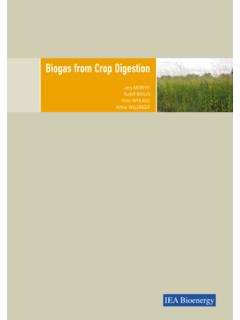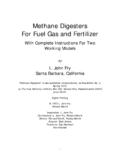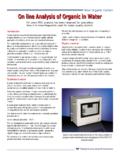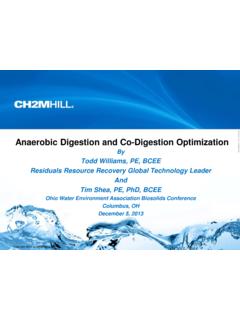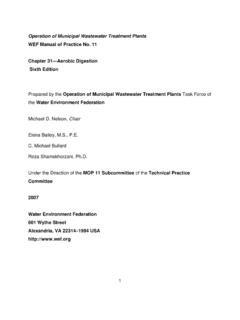Transcription of Aerobic and Anaerobic Biodegradation - Polimernet
1 Aerobic and Anaerobic Biodegradation This document provides an in depth explanation, detailing the processes of Aerobic and Anaerobic Biodegradation . It is intended for general audiences and will provide the reader with the necessary information to understand what is happening during the Biodegradation process. For those interested in the biochemical processes of the microbial organisms this document will provide a high level explanation of the Aerobic and Anaerobic processes. Biodegradation Biodegradation is the process by which organic substances are broken down into smaller compounds by the enzymes produced by living microbial organisms. The microbial organisms transform the substance through metabolic or enzymatic processes. Biodegradation processes vary greatly, but frequently the final product of the degradation is carbon dioxide or methane. Organic material can be degraded aerobically, with oxygen, or anaerobically, without oxygen.
2 Biodegradable matter is generally organic material such as plant and animal matter and other substances originating from living organisms, or artificial materials that are similar enough to plant and animal matter to be put to use by microorganisms. Some microorganisms have the astonishing, naturally occurring, microbial catabolic diversity to degrade, transform or accumulate a huge range of compounds including hydrocarbons ( oil), polychlorinated biphenyls (PCBs), polyaromatic hydrocarbons (PAHs), pharmaceutical substances, radionuclides and metals. Aerobic Biodegradation Aerobic Biodegradation is the breakdown of organic contaminants by microorganisms when oxygen is present. More specifically, it refers to occurring or living only in the presence of oxygen; therefore, the chemistry of the system, environment, or organism is characterized by oxidative conditions. Many organic contaminants are rapidly degraded under Aerobic conditions by Aerobic bacteria called aerobes.
3 Aerobic bacteria (aerobe) have an oxygen based metabolism. Aerobes, in a process known as cellular respiration, use oxygen to oxidize substrates (for example sugars and fats) in order to obtain energy. Before cellular respiration begins, glucose molecules are broken down into two smaller molecules. This happens in the cytoplasm of the aerobes. The smaller molecules then enter a mitochondrion, where Aerobic respiration takes place. Oxygen is used in the chemical reactions that break down the small molecules into water and carbon dioxide. The reactions also release energy. Polimernet Plastik :+90 216 393 77 46 / Email: 1 Fundementals of Aerobic & Anaerobic Biodegradation Process Aerobic , unlike Anaerobic digestion , does not produce the pungent gases. The Aerobic process results in a more complete digestion of waste solids reducing buildup by more than 50% in most cases. The Aerobic process also improves the environment of the workers and the animals and helps to keep pathogens in check.
4 Anaerobic Biodegradation Anaerobic digestion occurs when the Anaerobic microbes are dominant over the Aerobic microbes. Biodegradable waste in landfill degrades in the absence of oxygen through the process of Anaerobic digestion . Paper and other materials that normally degrade in a few years degrade more slowly over longer periods of time. Biogas contains methane which has approximately 21 times the global warming potential of carbon dioxide. In a cradle to cradle approach this biogas is collected and used for eco friendly power generation. Anaerobic digestion is a series of processes in which microorganisms break down biodegradable material in the absence of oxygen. It is widely used to treat wastewater sludge and biodegradable waste because it provides volume and mass reduction of the input material. As part of an integrated waste management system, Anaerobic digestion reduces the emission of landfill gas into the atmosphere.
5 Anaerobic digestion is a renewable energy source because the process produces Methane and Carbon dioxide rich biogas suitable for energy production helping replace Fossil fuels. Also, the nutrient rich solids left after digestion can be used as fertilizer. The Anaerobic Process The digestion process begins with bacterial hydrolysis of the input materials in order to break down insoluble organic polymers such as carbohydrates and make them available for other bacteria. Acetogen then convert the sugars and amino acids into carbon dioxide, hydrogen , ammonia , and organic acid. Acetogenic bacteria then convert these resulting organic acids into acetic acid, along with additional ammonia, hydrogen, and carbon dioxide. Methanogen finally are able to convert these products to methane and carbon dioxide. There are a number of bacteria that are involved in the process of Anaerobic digestion including acetic acid forming bacteria and methane forming bacteria.
6 These bacteria feed upon the initial feedstock, which undergoes a number of different processes converting it to intermediate molecules including sugars, hydrogen & acetic acid before finally being converted to biogas. Polimernet Plastik :+90 216 393 77 46 / Email: 2 Fundementals of Aerobic & Anaerobic Biodegradation Process Aerobic and Anaerobic Biodegradation There are four key biological and chemical stages of Anaerobic digestion : Hydrolysis Acidogenesis Acetogenesis Methanogenesis Hydrolysis In most cases biomass is made up of large organic polymers. In order for the bacteria in Anaerobic digesters to access the energy potential of the material, these chains must first be broken down into their smaller constituent parts. These constituent parts or monomers such as sugars are readily available by other bacteria. The process of breaking these chains and dissolving the smaller molecules into solution is called hydrolysis.
7 Therefore hydrolysis of these high molecular weight polymeric components is the necessary first step in Anaerobic digestion . Through Hydrolysis the complex organic molecules are broken down into simple sugars, amino acids, and Fatty acids. Acetate and hydrogen produced in the first stages can be used directly by methanogens. Other molecules such as volatile fatty acids (VFA's) with a chain length that is greater than acetate must first be catabolised into compounds that can be directly utilised by methanogens. Acidogenesis The biological process of Acidogenesis is where there is further breakdown of the remaining components by acidogenic (fermentative) bacteria. Here VFAs are created along with ammonia, carbon dioxide and Hydrogen sulfide as well as other by products. The process of acidogenesis is similar to the way that milk sours. Acetogenesis The third stage Anaerobic digestion is Acetogenesis . Here simple molecules created through the acidogenesis phase are further digested by acetogens to produce largely acetic acid as well as carbon dioxide and hydrogen.
8 Methanogenesis The terminal stage of Anaerobic digestion is the biological process of Methanogenesis. Here methanogens utilise the intermediate products of the preceding stages and convert them into methane, carbon dioxide and water. It is these components that makes up the majority of the biogas emitted from the system. Environmental Benefit Anaerobic digestion facilities have been recognized by the United Nations Development Program As one of the most useful decentralized sources of energy supply, as they are less capital intensive than large powerplants. Utilizing Anaerobic digestion technologies Polimernet Plastik :+90 216 393 77 46 / Email: 3 Fundementals of Aerobic & Anaerobic Biodegradation Processcan help to reduce the emission of greenhouse gases in a number of key ways: Replacement of fossil fuels Reducing methane emission from landfills Displacing industrially produced chemical fertilizers Reducing electrical grid transportation losses Methane and power produced in Anaerobic digestion facilities can be utilized to replace energy derived from fossil fuels, and hence reduce emissions of greenhouse gases.
9 This is due to the fact that the carbon in biodegradable material is part of a Carbon cycle. The carbon released into the atmosphere from the combustion of biogas has been removed by plants in order for them to grow in the recent past. This can have occurred within the last decade, but more typically within the last growing season. If the plants are re grown, taking the carbon out of the atmosphere once more, the system will be carbon neutral. This contrasts to carbon in fossil fuels that has been sequestered in the earth for many millions of years, the combustion of which increases the overall levels of carbon dioxide in the atmosphere. Bio Chemistry of a Micro Organism for Biodegradation Although food contains energy, it is not in a form that can be used by cells. Cellular respiration changes food energy into a form all cells can use. This energy drives the life processes of almost all organisms on Earth. Cellular respiration is the set of the metabolic reactions and processes that take place in organisms' cells to convert biochemical energy from nutrients into adenosine triphosphate (ATP), and then release waste products.
10 The reactions involved in respiration are catabolic reactions that involve the oxidation of one molecule and the reduction of another. Nutrients commonly used by animal and plant cells in respiration include glucose, amino acids and fatty acids, and a common oxidizing agent (electron acceptor) is molecular oxygen (O2). Bacteria organisms may respire using a broad range of inorganic molecules as electron donors and acceptors, such as sulfur, metal ions, methane or hydrogen. Organisms that use oxygen as a final electron acceptor in respiration are described as Aerobic , while those that do not are referred to as Anaerobic . When cells do not have enough oxygen for respiration, they use a process called fermentation to release some of the energy stored in glucose molecules. Like respiration, fermentation begins in the cytoplasm. Again, as the glucose molecules are broken down, energy is released. But the simple molecules from the breakdown of glucose do not move into the mitochondria.

